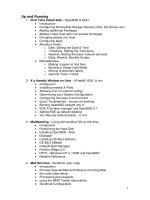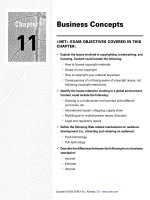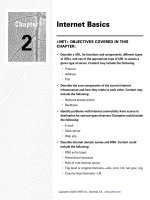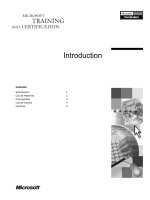Tài liệu Worldwide Training pdf
Bạn đang xem bản rút gọn của tài liệu. Xem và tải ngay bản đầy đủ của tài liệu tại đây (31.18 KB, 6 trang )
Cisco Systems
Worldwide Training
911 & E911: Standard
Telephony
911 & E911: Standard Telephony
__________________________________________
1 World Wide Training Copyright 2000, Cisco Systems, Inc. 10/5/01 2:44 AM
Introduction to 911 & E911
This document explores the development of 911, how 911 works, and the benefits of
911.
Objectives
Upon completion of this section you should be able to:
• Explain the history and development of the 911 System
• Describe how 911 works
• List the benefits of 911
• Identify references to standards, current news, and glossary of terms
The Development of 911
The three-digit telephone number "9-1-1" has been designated as the
"Universal Emergency Number," for citizens throughout the United States to
request emergency assistance. It is intended as a nationwide telephone number
and gives the public fast and easy access to a Public Safety Answering Point
(PSAP).
Single Emergency Number Recommended
In the United States, the first catalyst for a nationwide emergency telephone
number was in 1957, when the National Association of Fire Chiefs
recommended use of a single number for reporting fires.
In 1967, the President's Commission on Law Enforcement and Administration
of Justice recommended that a "single number should be established"
nationwide for reporting emergency situations. The use of different telephone
numbers for each type of emergency was determined to be contrary to the
purpose of a single, universal number. Other Federal Government Agencies
and various governmental officials also supported and encouraged the
recommendation. As a result of the immense interest in this issue, the
President's Commission on Civil Disorders turned to the Federal
Communications Commission (FCC) for a solution.
9-1-1 Established by AT&T
In November 1967, the FCC met with the American Telephone and Telegraph
Company (AT&T) to find a means of establishing a universal emergency
number that could be implemented quickly. In 1968, AT&T announced that it
would establish the digits 9-1-1 (nine-one-one) as the emergency code
throughout the United States.
911 & E911: Standard Telephony
__________________________________________
2 World Wide Training Copyright 2000, Cisco Systems, Inc. 10/5/01 2:44 AM
The code 9-1-1 was chosen because it best fit the needs of all parties involved.
First, and most important, it meets public requirements because it is brief,
easily remembered, and can be dialed quickly. Second, because it is a unique
number, never having been authorized as an office code, area code, or service
code, it best meets the long range numbering plans and switching
configurations of the telephone industry.
9-1-1 Confirmed by Congress
Congress backed AT&T's proposal and passed legislation allowing use of only
the numbers 9-1-1 when creating a single emergency calling service, thereby
making 9-1-1 a standard emergency number nationwide. A Bell System policy
was established to absorb the cost of central office modifications and any
additions necessary to accommodate the 9-1-1 code as part of the general rate
base. The Enhanced 9-1-1, or E9-1-1, subscriber is responsible for paying
network trunking costs according to tariffed rates, and for purchasing
answering equipment from the vendor of their choice.
9-1-1 First Used
On February 16, 1968, Senator Rankin Fite completed the first 9-1-1 call made
in the United States in Haleyville, Alabama. The serving telephone company
was Alabama Telephone Company, which later became Contel Corp. This
9-1-1 system is still in operation today. On February 22, 1968, Nome, Alaska
implemented 9-1-1 service.
Nationwide Adoption of 9-1-1
In March 1973, the White House's Office of Telecommunications issued a
national policy statement which recognized the benefits of 9-1-1, encouraged
the nationwide adoption of 9-1-1, and provided for the establishment of a
Federal Information Center to assist units of government in planning and
implementation. The intense interest in the concept of 9-1-1 can be attributed
primarily to the recognition of characteristics of modern society, i.e., increased
incidences of crimes, accidents, and medical emergencies, inadequacy of
existing emergency reporting methods, and the continued growth and mobility
of the population.
In the early 1970s, AT&T began the development of sophisticated features for
the 9-1-1 with a pilot program in Alameda County, California. The feature was
"selective call routing." This pilot program supported the theory behind the
Executive Office of Telecommunication's Policy. By the end of 1976, 9-1-1
was serving about 17% of the population of the United States. In 1979,
approximately 26% of the population of the United States had 9-1-1 service,
and nine states had enacted 9-1-1 legislation. At this time, 9-1-1 service was
growing at the rate of 70 new systems per year. By 1987, those figures had
grown to indicate that 50% of the US population had access to 9-1-1
emergency service numbers.
In addition, Canada recognized the advantages of a single emergency number
and chose to adopt 9-1-1 rather than use a different means of emergency
reporting service, thus unifying the concept and giving 9-1-1 international
stature.
911 & E911: Standard Telephony
__________________________________________
3 World Wide Training Copyright 2000, Cisco Systems, Inc. 10/5/01 2:44 AM
As we approach the end of the 20th century, some type of 9-1-1 service covers nearly
93% of the population of the United States. Ninety-five percent of that coverage is
Enhanced 9-1-1. Approximately 50% of the geographic US is covered by some type
of 9-1-1.
How 9-1-1 Works
/>htm
Although every system is unique, a 9-1-1 system works primarily in the following
way:
1. The three digit emergency number 9-1-1 is dialed.
2. The call is answered at a Public Safety Answering Point (PSAP).
3. The trained telecommunicator at the PSAP receives the emergency information
from the caller.
4. The telecommunicator dispatches the appropriate agency (police, fire, EMS) to
the emergency.
If people dial 9-1-1 in an area not served with a 9-1-1 system, they should receive a
telephone intercept that will notify them that they do not have 9-1-1 service and that
they should hang up and dial the appropriate seven-digit emergency number, or dial
"0" for the operator. There are urban/rural areas that use a fast busy signal instead of
the intercept. Some territories are 9-1-1 capable, but are not served by a 9-1-1 PSAP.
This is usually due to an emergency agency not wanting to participate in the system.
Instead, they use their own seven digit emergency number. The PSAP, upon receipt of
the call, will notify the appropriate agency of the call, even though they do not serve
that emergency agency.
The Benefits of 9-1-1
The major benefits of 9-1-1 to citizens and public safety agencies should be
understood by those involved in the planning and implementation of 9-1-1 systems.
The means by which 9-1-1 provides this benefit is primarily by saving time in the
overall response of a public safety agency.
The total time required in response to a perceived emergency is the sum of:
• Time from citizen perception of an emergency situation to the time he or she
reaches the correct public safety agency
• Time from receipt of a call by the agency to the time an emergency service
vehicle is dispatched to the scene of the emergency
and
• Time from the dispatch of the vehicle to the time it arrives at the scene of the
emergency
911 & E911: Standard Telephony
__________________________________________
4 World Wide Training Copyright 2000, Cisco Systems, Inc. 10/5/01 2:44 AM
A 9-1-1 system can save valuable minutes in that initial period of time when reaching
the appropriate emergency agency can mean life or death.
A number of surveys have been conducted on the problems citizens have in reaching
their public safety agencies. These surveys showed that fewer than 50% of the citizens
knew the telephone numbers of their own public safety agencies, and when citizens
are traveling, very few would know the appropriate agencies, much less the
emergency telephone numbers of those agencies. Citizens who did not know the
correct emergency telephone number relied on telephone books or direct calls (dial
"0") to telephone company operators.
Telephone operators have historically provided citizens with assistance through dial
"0" service. However, these operators are not highly trained in emergency service
requirements and they must search the telephone directories for the number to the
correct agency. An additional complication with the use of the telephone operator for
emergencies is the gradual reduction of the number of operator centers, which has
been caused by the automation of telephone switching centers. An operator reached
through dialing "0" in an emergency could be located more than 200 miles from the
caller, and would therefore be ill-equipped to assist the citizen in selecting the correct
agency.
Average call delays for citizens not knowing the correct number ranged from 1.0 to
3.5 minutes, depending upon the agency type and the number of agencies contacted
before the correct agency was reached. A full 20% of the citizens surveyed had an
average delay of 3.5 minutes because of failure to reach the correct agency on the first
contact. Additionally, 10% of these citizens needed assistance from more than one
type of agency.
These long delays in citizen access to public safety agencies are caused by citizen
confusion about agency identification and the lack of easily located emergency
number. By using 9-1-1 as a universal emergency number, both of these problem
areas will be eliminated. The three-digit number is easily remembered, and trained
answering personnel can quickly identify the correct agency and provide for the
transfer of the emergency information to that agency.
The benefits of reduced response times by emergency service agencies are quite clear.
A study of the President's Commission on Law Enforcement showed a direct
relationship between apprehension of criminals and low response time. A reduction of
an average of only one-minute in fire response time could probably save millions of
dollars annually in any state. Finally, a reduction in response time for ambulance and
rescue units will reduce the death rate in heart attack, injury accident, and other life
and death medical emergencies. An important but somewhat less visible benefit of
9-1-1 is the more efficient, more cost-effective use of scarce emergency service
resources for the public benefit.
References
q NEMA’s Telecom Standard & Training for your State
911 & E911: Standard Telephony
__________________________________________
5 World Wide Training Copyright 2000, Cisco Systems, Inc. 10/5/01 2:44 AM
Go to and click on your
state.
q Wireless E9-1-1, Current NEMA News Releases
Go to
q Glossary of Terms [E911 & 911]
Go to









